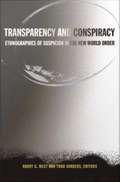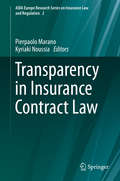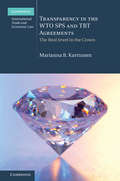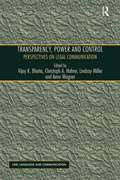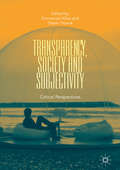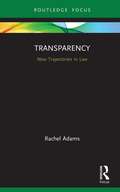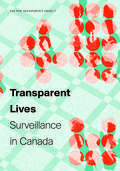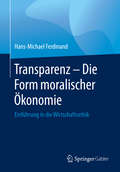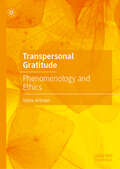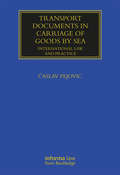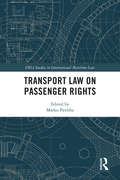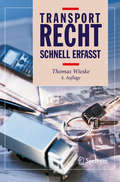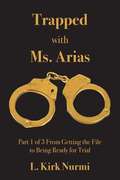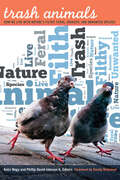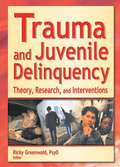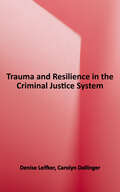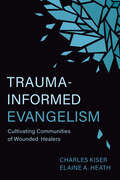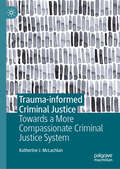- Table View
- List View
Transparency and Conspiracy: Ethnographies of Suspicion in the New World Order
by Harry G. West Todd SandersTransparency has, in recent years, become a watchword for good governance. Policymakers and analysts alike evaluate political and economic institutions--courts, corporations, nation-states--according to the transparency of their operating procedures. With the dawn of the New World Order and the "mutual veil dropping" of the post-Cold War era, many have asserted that power in our contemporary world is more transparent than ever. Yet from the perspective of the relatively less privileged, the operation of power often appears opaque and unpredictable. Through vivid ethnographic analyses, Transparency and Conspiracy examines a vast range of expressions of the popular suspicion of power--including forms of shamanism, sorcery, conspiracy theory, and urban legends--illuminating them as ways of making sense of the world in the midst of tumultuous and uneven processes of modernization. In this collection leading anthropologists reveal the variations and commonalities in conspiratorial thinking or occult cosmologies around the globe--in Korea, Tanzania, Mozambique, New York City, Indonesia, Mongolia, Nigeria, and Orange County, California. The contributors chronicle how people express profound suspicions of the United Nations, the state, political parties, police, courts, international financial institutions, banks, traders and shopkeepers, media, churches, intellectuals, and the wealthy. Rather than focusing on the veracity of these convictions, Transparency and Conspiracy investigates who believes what and why. It makes a compelling argument against the dismissal of conspiracy theories and occult cosmologies as antimodern, irrational oversimplifications, showing how these beliefs render the world more complex by calling attention to its contradictions and proposing alternative ways of understanding it. Contributors. Misty Bastian, Karen McCarthy Brown, Jean Comaroff, John Comaroff, Susan Harding, Daniel Hellinger, Caroline Humphrey, Laurel Kendall, Todd Sanders, Albert Schrauwers, Kathleen Stewart, Harry G. West
Transparency in Health and Health Care in the United States: Law and Ethics
by Holly Fernandez Lynch I. Glenn Cohen Carmel Shachar Barbara J. EvansTransparency is a concept that is becoming increasingly lauded as a solution to a host of problems in the American health care system. Transparency initiatives show great promise, including empowering patients and other stakeholders to make more efficient decisions, improve resource allocation, and better regulate the health care industry. Nevertheless, transparency is not a cure-all for the problems facing the modern health care system. The authors of this volume present a nuanced view of transparency, exploring ways in which transparency has succeeded and ways in which transparency initiatives have room for improvement. Working at the intersection of law, medicine, ethics, and business, the book goes beyond the buzzwords to the heart of transparency's transformative potential, while interrogating its obstacles and downsides. It should be read by anyone looking for a better understanding of transparency in the health care context.
Transparency in Insurance Contract Law (AIDA Europe Research Series on Insurance Law and Regulation #2)
by Kyriaki Noussia Pierpaolo MaranoThis Volume of the AIDA Europe Research Series on Insurance Law and Regulation focuses on transparency as the guiding principle of modern insurance law. It consists of chapters written by leaders in the respective field, who address transparency in a range of civil and common law jurisdictions, along with overview chapters. Each chapter reviews the transparency principles applicable in the jurisdiction discussed. Whether expressly or impliedly, all jurisdictions recognize a duty on the part of the insured to make a fair presentation of the risk when submitting a proposal for cover to the insurers, although there is little consensus on the scope of that duty. Disputed matters in this regard include: whether it is satisfied by honest answers to express questions, or whether there is a spontaneous duty of disclosure; whether facts relating to the insured’s character, as opposed to the nature of the risk itself, are to be presented to the insurers; the role of insurance intermediaries in the placement process; and the remedy for breach of duty. Transparency is, however, a much wider concept. Potential policyholders are in principle entitled to be made aware of the key terms of coverage and to be warned of hidden traps (such as conditions precedent, average clauses and excess provisions), but there are a range of different approaches. Some jurisdictions have adopted a “soft law” approach, using codes of practice for pre-contract disclosure, while other jurisdictions employ the rather nebulous duty of (utmost) good faith. Leaving aside placement, transparency is also demanded after the policy has been incepted. The insured is required to be transparent during the claims process. There is less consistency in national legislation regarding the implementation of transparency by insurers in the context of handling claims.
Transparency in Insurance Regulation and Supervisory Law: A Comparative Analysis (AIDA Europe Research Series on Insurance Law and Regulation #4)
by Kyriaki Noussia Pierpaolo MaranoThis volume focuses on transparency as the guiding principle for insurance regulation and supervisory law. All chapters were written by experts in their respective fields, who address transparency in a wide range of European and non-European jurisdictions. Each chapter reviews the transparency principles applicable in the jurisdiction discussed. While the European jurisdictions reflect different facets of the principle as emerging from EU law on insurance, the principle has developed quite differently in other jurisdictions.
Transparency in International Investment Arbitration
by Euler, Dimitrij and Gehring, Markus and Scherer, Maxi and Wong, Meagan and Hadgett, Rebecca Dimitrij Euler Markus Gehring Maxi Scherer Meagan Wong Rebecca HadgettThe topic of transparency in international investment arbitration is gaining increasing attention. This in-depth commentary analyses the UNCITRAL Rules on Transparency in Treaty-Based Investor-State Arbitration, one of the most recent and innovative developments in international law. Focusing on the application of these rules, contributors analyse the issue of transparency in investment law more broadly and provide in-depth guidance on how to apply the UNCITRAL transparency rules. Chapters encompass all treaty-based disputes between investors and state, examining the perspectives of disputing parties, third parties, non-disputing state parties and arbitral tribunals. The contributors each have a strong background in investment arbitration, in both professional practice and academia. This commentary will be of interest to all actors involved in investment arbitrations, especially practitioners, counsels, NGOs and scholars in the fields of international law, commercial arbitration and investor-state arbitration.
Transparency in International Law
by Anne Peters Andrea BianchiWhile its importance in domestic law has long been acknowledged, transparency has until now remained largely unexplored in international law. This study of transparency issues in key areas such as international economic law, environmental law, human rights law and humanitarian law brings together new and important insights on this pressing issue. Contributors explore the framing and content of transparency in their respective fields with regard to proceedings, institutions, law-making processes and legal culture, and a selection of cross-cutting essays completes the study by examining transparency in international law-making and adjudication.
Transparency in the WTO SPS and TBT Agreements: The Real Jewel in the Crown (Cambridge International Trade and Economic Law)
by Marianna B. KarttunenTransparency of trade regulations by all WTO Members is essential for open, fair and predictable trade relations. A myriad of different regulations apply in all WTO Members and have the potential for affecting international trade. The Agreements on the Application of Sanitary and Phytosanitary measures and on Technical Barriers to Trade provide the most comprehensive frameworks in the WTO to address the costs arising from such regulatory diversity, through obligations on regulatory transparency and co-operation. This book gives a detailed account of the legal disciplines of the two Agreements, an in-depth presentation of discussions between WTO Members, and an overview of the few cases that end up in formal dispute settlement. It shows that the strength of the WTO legal and institutional system goes well beyond its dispute settlement system, with transparency enabling implementation of WTO obligations through better information sharing and co-operation among Members themselves, through non-judicial means.
Transparency, Power, and Control: Perspectives on Legal Communication (Law, Language and Communication)
by Anne Wagner Christoph A. HafnerThis book brings together academics and practitioners from a range of disciplines from more than twenty countries to reflect on the growing importance of transparency, power and control in our international community and how these concerns and ideas have been examined, used and interpreted in a range of national and international contexts. Contributors explore these issues from a range of overlapping concerns and perspectives, such as semiotic, sociolinguistic, psychological, philosophical, and visual in diverse socio-political, administrative, institutional, as well as legal contexts. The collection examines the ways in which 'actors' in our society - legislators, politicians, activists, and artists - have provoked public discourses to confront these issues.
Transparency, Society and Subjectivity: Critical Perspectives
by Emmanuel Alloa Dieter ThomäThis book critically engages with the idea of transparency whose ubiquitous demand stands in stark contrast to its lack of conceptual clarity. The book carefully examines this notion in its own right, traces its emergence in Early Modernity and analyzes its omnipresence in contemporary rhetoric. Today, transparency has become a catchword outplaying other Enlightenment values like empowerment, sincerity and the notion of a public sphere. In a suspicious manner, transparency is entangled in the discourses on power, surveillance, and self-exposure. Bringing together prominent scholars from the emerging field of Critical Transparency Studies, the book offers a map of the various sites at which transparency has become virulent and connects the dots between past and present. By studying its appearances in today’s hyper-mediated economies of information and by linking it back to its historical roots, the book analyzes transparency and its discontents, and scrutinizes the reasons why it has become the imperative of a supposedly post-ideological age.
Transparency: New Trajectories in Law (New Trajectories in Law)
by Rachel AdamsThis book critiques the contemporary recourse to transparency in law and policy. This is, ostensibly, the information age. At the heart of the societal shift toward digitalisation is the call for transparency and the liberalisation of information and data. Yet, with the recent rise of concerns such as 'fake news', post-truth and misinformation, where the policy responses to all these phenomena has been a petition for even greater transparency, it becomes imperative to critically reflect on what this dominant idea means, whom it serves, and what the effects are of its power. In response, this book provides the first sustained critique of the concept of transparency in law and policy. It offers a concise overview of transparency in law and policy around the world, and critiques how this concept works discursively to delimit other forms of governance, other ways of knowing and other realities. It draws on the work of Michel Foucault on discourse, archaeology and genealogy, together with later Foucaultian scholars, including Gayatri Chakravorty Spivak and Judith Butler, as a theoretical framework for challenging and thinking anew the history and understanding of what has become one of the most popular buzzwords of 21st century law and governance. At the intersection of law and governance, this book will be of considerable interest to those working in these fields; but also to those engaged in other interdisciplinary areas, including society and technology, the digital humanities, technology laws and policy, global law and policy, as well as the surveillance society.
Transparent Lives: Surveillance in Canada
by David Lyon Valerie Steeves Kevin D. Haggerty Colin J. Bennett"Although most Canadians are familiar with surveillance cameras and airport security, relatively few are aware of the extent to which the potential for surveillance is now embedded in virtually every aspect of our lives. We cannot walk down a city street, register for a class, pay with a credit card, hop on an airplane, or make a telephone call without data being captured and processed. Where does such information go? Who makes use of it, and for what purpose? Is the loss of control over our personal information merely the price we pay for using social media and other forms of electronic communication, or should we be wary of systems that make us visible—and thus vulnerable—to others as never before? The work of a multidisciplinary research team, Transparent Lives explains why and how surveillance is expanding—mostly unchecked—into every facet of our lives. Through an investigation of the major ways in which both government and private sector organizations gather, monitor, analyze, and share information about ordinary citizens, the volume identifies nine key trends in the processing of personal data that together raise urgent questions of privacy and social justice. Intended not only to inform but to make a difference, the volume is deliberately aimed at a broad audience, including legislators and policymakers, journalists, civil liberties groups, educators, and, above all, the reading public."
Transparenz - Die Form moralischer Ökonomie: Einführung in die Wirtschaftsethik
by Hans-Michael FerdinandDas vorliegende Buch ist das leidenschaftliche Plädoyer für die moralische Orientierung der ÖkonomieEs geht aus von der aristotelischen Forderung an ökonomisches Handeln, ein gutes Leben zu ermöglichen. Die dadurch erzeugte enge Verbindung von Ethik und Ökonomie ist seit der Aufklärung im Namen einer falsch verstandenen Freiheit nach und nach verloren gegangen bzw. aufgegeben worden – zugunsten eines mathematisch-mechanischen Funktionsverständnisses der Wirtschaft, in dem für moralisches Handeln kaum Platz bleibt. Auch die Politik scheint heute ihren Einfluss auf die Ökonomie zu reduzieren und übt sich in „marktkonformem“ Handeln. Die Kritik an dem dafür ursächlichen neoliberalen Programm führt zur Begründung einer moralischen Ökonomie, die den aristotelischen Gedanken der Lebensdienlichkeit mit der Wucht der neuzeitlichen Freiheitsidee verbindet, wie sie vor allem in der Tradition von Immanuel Kant vertreten wurde. Öffentlicher Vernunftgebrauch und Transparenz von Entscheidungen werden als die wesentlichen Formanforderungen einer solchen moralischen Ökonomie aufgewiesen.Das Buch bietet durch fünf thematische Schwerpunkte eine umfassende Einführung in die Wirtschaftsethik: Ökonomisches Handeln und MoralÖkonomik – Werkzeug zum guten Leben Kritik der ökonomischen Moral Eine moralische Ökonomie Transparenz – Form moralischer Ökonomie
Transpersonal Gratitude: Phenomenology and Ethics
by Taline ArtinianIn this book, Taline Artinian takes a critical look at the existing discussion on dyadic forms of gratitude, from propositional to non-directed, and develops the concept of transpersonal gratitude, which captures the experience of thankfulness for a personally significant good in the absence of a benefactor. The concept of gratitude in philosophy has historically been centred around a triadic experience of gift, giver, and receiver, and it is only in the last two decades that a dyadic conceptualisation has begun to develop. Artinian focuses on the phenomenology and the ethical significance of transpersonal gratitude, to argue that this experience goes beyond mere appreciation or gladness and that its conceptualisation offers a framework for the understanding of gratitude as a virtue. This book also examines transpersonal gratitude as an experience and disposition that shape our engagement with others and with the world at large. By situating it in relation to empathy, humility, and the fostering of a sense of connectedness, it argues for the role of transpersonal gratitude as a key component of the morally good and flourishing life.
Transport Documents in Carriage Of Goods by Sea: International Law and Practice (Maritime and Transport Law Library)
by Časlav PejovićBringing a fresh, comparative approach to transport documents used in the carriage of goods by sea, this book covers bills of lading, sea waybills, ship’s delivery orders, multimodal transport documents, and electronic transport documents. The book covers historic developments, current conventions, and thoughts for the future on these transport documents; and delves deeply into the legal issues concerning them. It represents a comprehensive compilation of case and statute law from around the world on this subject. In addition to English law, the book covers American, French, German, and Italian laws, as well as the laws of several East Asian jurisdictions (China, Japan, South Korea). Primarily, the book will be of use to maritime law scholars and students, and lawyers who deal with shipping. It may also be of interest to international traders, banks, and ship masters and officers.
Transport Law on Passenger Rights (IMLI Studies in International Maritime Law)
by Marko PavlihaEurope and also the rest of the world has experienced a boom in mobility over the last thirty years. In light of the protection of increasing number of consumers – passengers it is almost logical that during the past few decades, international and European transport law has developed almost to revolutionary extent, especially in the field of private aviation (air) law with the introduction of unlimited liability of carriers for death and injury of passengers and commendable sophisticated rights in case of denied boarding, cancellation of flights and long delays. This book will cast light through a critical prism on the most important characteristics of the international transport law, the EU legislation and jurisprudence regarding passenger rights during the carriage by air, sea, rail and road. One of the ideas which, however, needs further research is that the commendable legal solutions and experience of the EU can serve as an excellent framework for a new holistic international convention on passengers rights in all transport modes.
Transportrecht - Schnell erfasst: Schnell Erfasst (Recht - schnell erfasst)
by Thomas WieskeÜbersichtlich strukturiert und prägnant zusammengefasst, vermittelt der Band die Grundlagen des Transportrechts: vom deutschen Gütertransportrecht über das Speditions-, Umzugs- und Lagerrecht bis zu den internationalen Regelungen des Transportrechts. Die wichtigsten gesetzlichen Normen werden im Wortlaut vorgestellt, verständlich kommentiert und in Schaubildern und Übersichten zusammenfassend dargestellt. Auch die nationalen und internationalen Speditionsbedingungen finden Berücksichtigung.
Trap (A Butch Karp-Marlene Ciampi Thriller #27)
by Robert K. Tanenbaum“The pace is fast, the courtroom scenes make you feel like you’re there” (Kirkus Reviews)—a devastating deadly explosion sets a breakneck tone that never lets up in New York Times bestselling author Robert K. Tanenbaum’s action-packed Butch Karp legal drama.A tremendous fatal blast rocks a book-signing event where supporters have gathered to see the inspirational leading advocate for New York City charter schools, a Holocaust survivor. A neo-Nazi is the prime suspect, but District Attorney Butch Karp believes the hate crime may be a cover-up for a more sinister plot. The treacherous teacher’s union president has long been furious at the unqualified successes of the charter school movement, which threatens to expose his corrupt practices—manipulation and misappropriation of union funds and, now, possibly even murder. But is there another motive behind the attack that could derail the case? How will Karp discover the set-up, and can he do so in time to bring justice? This exciting legal thriller ends in a dramatic courtroom showdown that proves New York Times bestselling author Robert K. Tanenbaum is always at the top of his game.
Trapped With Ms. Arias: Part 1 of 3 From Getting The File To Being Ready for Trial (Trapped With Ms. Arias)
by L. Kirk NurmiMost people became interested in the State of Arizona v. Jodi Arias January 2, 2013, when opening statements were delivered. Over time that interest became a media sensation and a world-wide phenomenon. However, as her attorney I know that what you saw at trial is only part of the story. Have you ever wondered what happened before the trial began, what it was like to deal with Ms. Arias when the cameras were not rolling? In this book I detail for the reader what happened before the case began, what happened before the cameras were on. I detail the things that you do not know, things that will describe my reality, the reality that I was "Trapped with Ms. Arias."
Trapped in a Maze: How Social Control Institutions Drive Family Poverty and Inequality
by Leslie PaikTrapped in a Maze provides a window into families' lived experiences in poverty by looking at their complex interactions with institutions such as welfare, hospitals, courts, housing, and schools. Families are more intertwined with institutions than ever as they struggle to maintain their eligibility for services and face the possibility that involvement with one institution could trigger other types of institutional oversight. Many poor families find themselves trapped in a multi-institutional maze, stuck in between several systems with no clear path to resolution. Tracing the complex and often unpredictable journeys of families in this maze, this book reveals how the formal rationality by which these institutions ostensibly operate undercuts what they can actually achieve. And worse, it demonstrates how involvement with multiple institutions can perpetuate the conditions of poverty that these families are fighting to escape.
Trapped in a Vice: The Consequences of Confinement for Young People
by Alexandra CoxTrapped in a Vice explores the consequences of a juvenile justice system that is aimed at promoting change in the lives of young people, yet ultimately relies upon tools and strategies that enmesh them in a system that they struggle to move beyond. The system, rather than the crimes themselves, is the vice. Trapped in a Vice explores the lives of the young people and adults in the criminal justice system, revealing the ways that they struggle to manage the expectations of that system; these stories from the ground level of the justice system demonstrate the complex exchange of policy and practice.
Trash Animals: How We Live with Nature’s Filthy, Feral, Invasive, and Unwanted Species
by Kelsi Nagy Phillip David Johnson IIWhy are some species admired or beloved while others are despised? An eagle or hawk circling overhead inspires awe while urban pigeons shuffling underfoot are kicked away in revulsion. Fly fishermen consider carp an unwelcome trash fish, even though the trout they hope to catch are often equally non-native. Wolves and coyotes are feared and hunted in numbers wildly disproportionate to the dangers they pose to humans and livestock. In Trash Animals, a diverse group of environmental writers explores the natural history of wildlife species deemed filthy, unwanted, invasive, or worthless, highlighting the vexed relationship humans have with such creatures. Each essay focuses on a so-called trash species—gulls, coyotes, carp, cockroaches, magpies, prairie dogs, and lubber grasshoppers, among others—examining the biology and behavior of each in contrast to the assumptions widely held about them. Identifying such animals as trash tells us nothing about problematic wildlife but rather reveals more about human expectations of, and frustrations with, the natural world. By establishing the unique place that maligned species occupy in the contemporary landscape and in our imagination, the contributors challenge us to look closely at these animals, to reimagine our ethics of engagement with such wildlife, and to question the violence with which we treat them. Perhaps our attitudes reveal more about humans than they do about the animals. Contributors: Bruce Barcott; Charles Bergman, Pacific Lutheran U; James E. Bishop, Young Harris College; Andrew D. Blechman; Michael P. Branch, U of Nevada, Reno; Lisa Couturier; Carolyn Kraus, U of Michigan–Dearborn; Jeffrey A. Lockwood, U of Wyoming; Kyhl Lyndgaard, Marlboro College; Charles Mitchell, Elmira College; Kathleen D. Moore, Oregon State U; Catherine Puckett; Bernard Quetchenbach, Montana State U, Billings; Christina Robertson, U of Nevada, Reno; Gavan P. L. Watson, U of Guelph, Ontario, Canada.
Trauma and Juvenile Delinquency: Theory, Research, and Interventions
by Ricky GreenwaldLearn how and why trauma is relevant to juvenile delinquency-and what to do about it! This groundbreaking book addresses the connection between childhood trauma and juvenile delinquency. Trauma and Juvenile Delinquency: Theory, Research, and Interventions begins with two chapters presenting theoretical models of the relationship between trauma and the development/persistence of antisocial behavior. Another chapter addresses trauma-related assessment issues for juveniles, and several chapters present cutting-edge research on various aspects of the relationship between trauma and delinquency. Finally, several chapters focus on theory-based and empirically supported trauma-focused therapeutic interventions for juvenile delinquents. No other single source provides such breadth and depth of coverage on this topic! From the editor: "Disruptive behavior disorders are by far the largest type of mental health referral for children and adolescents, while juvenile crime and violence continue to be major social concerns. Several bodies of literature have converged to suggest that trauma is more than incidental to the problem of juvenile delinquency, it contributes to the problem." Trauma and Juvenile Delinquency: Theory, Research, and Interventions explores: how trauma relates to conduct disorder the connection between traumatic victimization and oppositional/defiance problems ways to assess PTSD in adolescents how exposure to violence, delinquent activity, and posttraumatic stress symptomatology are related the unique trauma histories of incarcerated girls and the problems they have adjusting to life within the juvenile justice system how to develop group therapy services for incarcerated male juvenile offenders with PTSD This valuable book also examines the effectiveness of EMDR (Eye Movement Desensitization and Reprocessing) for boys with conduct problems, MASTR (Motivation - Adaptive Skills - Trauma Resolution) for teens with school-related problems, and CPT (Cognitive Processing Therapy) for juvenile delinquents with post-traumatic stress disorder.
Trauma and Resilience in the Criminal Justice System
by Denise Leifker Carolyn DallingerTrauma and Resilience in the Criminal Justice System will help criminal justice practitioners and students develop skills to be the most effective professionals possible by increasing awareness and pointing out places for empathy and change. Readers will examine the enforcement, court, and correctional systems to determine where trauma plays a destructive part. From the point of view of police, detectives, judges, jurors, attorneys, correctional and probation officers, prisoners, and others, the reader will learn the potentially harmful and sometimes devastating impacts of trauma. Readers will also learn from practicing criminal justice officials some potentially impactful actions they can take to build resilience. This book could lead to new perspectives and methods in improving the future of the criminal justice system.
Trauma-Informed Evangelism: Cultivating Communities of Wounded Healers
by Elaine Heath Charles Kiser&“We are at the forefront of a new reformation.&” So declares Elaine Heath in Trauma-Informed Evangelism, aiming to recover the God of love from the structures of hate that pervade Christian communities in America today. In their new guide, she and Charles Kiser work toward bringing this reformation to fruition through ministering specifically to the spiritually traumatized. Over the course of their study, Kiser and Heath amplify the voices of those who suffered misogynistic, racist, or homophobic abuse at the hands of the church. While carefully listening to these stories, Kiser and Heath bring them into conversation with the passion and resurrection of Jesus. Engaging with womanist and liberation theology, they see in the crucifixion a God who does not valorize suffering but shares the experience of the traumatized. Ultimately, this theodicy leads them to propose a new evangelism—one based not on fear and coercion but on witnessing the unconditional love of God. Timely, theologically informed, and eminently practical, Trauma-Informed Evangelism will serve as a formative guide for church leaders and students seeking to aid trauma survivors in their communities. Discussion questions conclude each chapter.
Trauma-informed Criminal Justice: Towards a More Compassionate Criminal Justice System
by Katherine J. McLachlanThis book is the first to examine trauma-informed criminal justice responses to the commission of crime and its impact through empathy and humanity. Trauma-informed criminal justice uses compassion to achieve a safer community for everyone. There are three parts: the first examines how adversity, trauma and crime are related. The second focuses on trauma-informed criminal justice responses to people who have offended, victims of crime, and professionals at risk of vicarious trauma. The third focuses on trauma-informed sentencing and compassionate justice through therapeutic jurisprudence and judicial empathy. Each chapter is designed to be a stand-alone resource.
